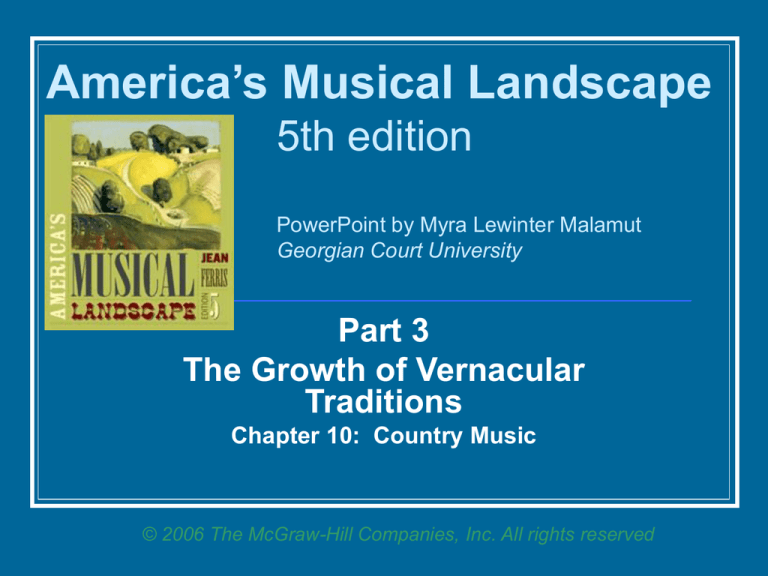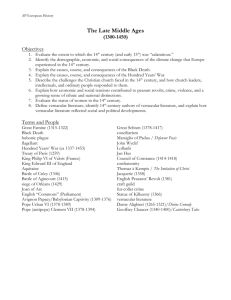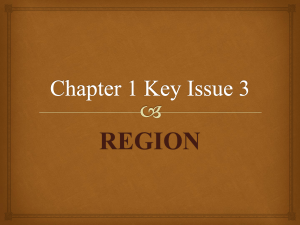
America’s Musical Landscape
5th edition
PowerPoint by Myra Lewinter Malamut
Georgian Court University
Part 3
The Growth of Vernacular
Traditions
Chapter 10: Country Music
© 2006 The McGraw-Hill Companies, Inc. All rights reserved
Country Music
Various vernacular musics evolved in America’s
rural and urban environments in the 19th century
People living in remote areas in the Eastern hills
continued to sing and play their traditional music
as it had been performed by their ancestors
These people were isolated from mainstream popular
music and unaffected by modern trends
Through oral tradition, the people passed through the
generations the old tunes and customs
Early folk ballads, originally from the British Isles, such as
“Barbara Allen” were preserved
© 2006 by The McGraw-Hill Companies, Inc.
All rights reserved.
Part 3: The Growth of Vernacular Traditions
Chapter 10: Country Music
2
After the Civil War
New influences invaded all
areas, including isolated
mountains
Music and other aspects
of life were affected
Migrant workers came to
the rural hills and brought
new kinds of music and
new musical instruments,
including the 5-string banjo
© 2006 by The McGraw-Hill Companies, Inc.
All rights reserved.
Part 3: The Growth of Vernacular Traditions
Chapter 10: Country Music
Banjo
3
Mountain People took temporary jobs
in cities
These people brought home new subjects for
songs and new musical sounds
New “folk” songs evolved
Similar to the traditional ballads
But characteristically American in subject and style
Sometimes people lost track of a song’s origin
A song included in the “folk” repertoire might actually have
been composed rather than improvised, memorized, and
passed down in the traditional ways
© 2006 by The McGraw-Hill Companies, Inc.
All rights reserved.
Part 3: The Growth of Vernacular Traditions
Chapter 10: Country Music
4
From Country to City
The early 1920s
Commercial recording companies began to send
talent scouts into the hill country
To search for folk singers and instrumentalists with
a distinctive sound
To entice country musicians to come to the cities,
where the market for recordings of “old time”
music was increasing
© 2006 by The McGraw-Hill Companies, Inc.
All rights reserved.
Part 3: The Growth of Vernacular Traditions
Chapter 10: Country Music
5
Hillbilly Music
The term “hillbilly music” was
coined in 1925
“Hillbilly music” somewhat scornfully
referred to music of
Country fiddlers
Harmonica players
Singers of country ballads
“Old-time,” “hillbilly,” and “country,”
traditional music from the hills
The term Hillbilly Music came from
a 4-musician group from Virginia
named the Hill Billies, who
recorded music
© 2006 by The McGraw-Hill Companies, Inc.
All rights reserved.
Part 3: The Growth of Vernacular Traditions
Chapter 10: Country Music
A fiddle was a violin
6
Hill musicians
Traveled with tent shows, medicine shows, and vaudeville
shows
Amazed audiences with virtuosic performances at fiddlers’
contests
At country fairs they sang songs about love, work, family life,
death in a semidetached impersonal manner that made their
music all the more moving
City listeners enjoyed the music, and the audience for
country music continued to expand
© 2006 by The McGraw-Hill Companies, Inc.
All rights reserved.
Part 3: The Growth of Vernacular Traditions
Chapter 10: Country Music
7
As commercal radio evolved
Hillbilly music proved widely popular
“Barn dance” radio shows sprang up in the
South and throughout the Midwest
The most famous of these shows was the Grand
Ole Opry
Debuted on a station in Nashville, Tennessee, in
1924
Instrumental in establishing Nashville as the all
time base for the country music industry
© 2006 by The McGraw-Hill Companies, Inc.
All rights reserved.
Part 3: The Growth of Vernacular Traditions
Chapter 10: Country Music
8
Effects of popularity and
commercialization of Hillbilly Music
The end of the old way—the oral tradition—of preserving
original folk songs and performance practices
The commercial market required a constant supply of new
pieces
Ballads were popular
Country musicians adapted by writing new songs and
performing them in a manner acceptable to a city audience
Many were about the dramatic current events of the day
People lost track of which folk songs were traditional and
which were created by modern professionals
© 2006 by The McGraw-Hill Companies, Inc.
All rights reserved.
Part 3: The Growth of Vernacular Traditions
Chapter 10: Country Music
9
By 1927 two different strains of
hillbilly music reached the public:
One introduced by Jimmie Rodgers, from
Mississippi in the Deep South
The other made popular by the Carter
Family, a singing family from the mountains
of Virginia
© 2006 by The McGraw-Hill Companies, Inc.
All rights reserved.
Part 3: The Growth of Vernacular Traditions
Chapter 10: Country Music
10
Jimmie Rodgers (1897-1933)
Wandered through several states during his brief career; had
little formal music training
Played guitar while singing in a clear tenor voice
Often used the vocal falsetto range
Known and imitated for his yodel, a rapid alternation between
the full voice and falsetto
Known for his thirteen songs called “blue yodels”, with form and
harmonies of twelve-bar blues
Nicknamed the “singing brakeman” for singing about his
experiences working on the railroad, along with other topics
such as love gone wrong, cowboys, his Southern home, etc.
© 2006 by The McGraw-Hill Companies, Inc.
All rights reserved.
Part 3: The Growth of Vernacular Traditions
Chapter 10: Country Music
11
Listening example 33
Blue Yodel No. 9
Composed by Jimmie Rodgers
Sung by Jimmie Rodgers
Accompanied by
Louis Armstrong, trumpet
Lil Hardin Armstrong, piano
Listening guide page 167
Form: Strophic
Tempo: Moderately slow
© 2006 by The McGraw-Hill Companies, Inc.
All rights reserved.
Part 3: The Growth of Vernacular Traditions
Chapter 10: Country Music
Notice the sound of
Rodgers’ yodel.
During his lifetime
Rodgers established the
solo song as an
important part of hillbilly
music.
Rodgers was the first
person elected to the
Country Music Hall of
Fame in Nashville.
12
The Carter Family:
From the Mountains of Virginia
Symbolized the close, conservative family: Alvin Pleasant
Delaney (A. P.) Carter (1891-1960); Sara Carter, the wife of
A. P.; and, Maybelle, Sara’s cousin and A. P.’s sister-in-law
Sang traditional songs, ballads, and hymns in pinched nasal
voices and tight harmony characteristic of mountain people
Favored ragtime and early jazz rhythms
Spiked their music with a zesty backbeat (accents on beats two
and four instead of the usual one and three)
Songs: Ballads about train wrecks and disasters, sentimental
songs about mountain flowers, country churchs, and lovely pale
maidens, plus hymns and joyful camp meeting spirituals
© 2006 by The McGraw-Hill Companies, Inc.
All rights reserved.
Part 3: The Growth of Vernacular Traditions
Chapter 10: Country Music
13
Listening Example 34
Chinese Breakdown
By The Carter Family
Performed by
Sarah Carter, autoharp
Maybelle Carter, guitar
Listening guide page 34
During the 1920s and
1930s the Carter Family
collected, arranged and
recorded hundreds of
American traditional
songs, spirituals, and
folk songs, laying the
foundation for modern
country music.
Carter heirs, including
June Carter (1929-2003)
continue to perform.
Meter: Duple
Style: Mountain music
Hear the “Carter Scratch”: Picking a melody on the bass strings
Autoharp: A folk instrument whose strings are strummed or plucked
with one hand as the other hand presses buttons to form chords
© 2006 by The McGraw-Hill Companies, Inc.
All rights reserved.
Part 3: The Growth of Vernacular Traditions
Chapter 10: Country Music
14
Johnny Cash, the “Man in Black”
(1932-2003)
Cash, June Carter’s third husband, was not part of the country music
establishment
Cash had ties to rockabilly, but his best songs sounded like country music,
including “I Walk the Line,” and, “The Green, Green Grass of Home”
1992: Inducted into the Rock and Roll Hall of Fame
Cash was country music’s first protest singer
Roseanne Cash, daughter of June Carter and Johnny Cash, has been a
major country music performer since the 1980s
Grammy winner Roseann Cash mixes country, folk, pop, and rock
Roseann’s stepsister Carlene Carter combines rock and country
© 2006 by The McGraw-Hill Companies, Inc.
All rights reserved.
Part 3: The Growth of Vernacular Traditions
Chapter 10: Country Music
15
Listening Example 35
The Ballad of Casey Jones
Words by Wallace Saunders
Melody: Anonymous
Sung by Johnny Cash
Listening guide page 169
Written by a black
laborer who never
received a penny for the
song, white entertainers
made this into one of the
most popular and
enduring American
ballads. The lyrics tell
the story of train
engineer Casey Jones,
who sped his train for
passengers to arrive on
time at their destination
without injury, as he
sacrificed himself in the
ensuing train wreck.
Form: Verse-chorus
Tempo: Fast
Meter: Quadruple
Accompaniment: Banjo, background choral harmonies
Hear a train whistle and a percussion instrument’s rhythmic “chugging”
© 2006 by The McGraw-Hill Companies, Inc.
All rights reserved.
Part 3: The Growth of Vernacular Traditions
Chapter 10: Country Music
16
Styles of Country Music
By the 1920s Americans had radios and heard
Hillbilly or old-time music
White religious music called gospel performed by country
singers accompanied by fiddle, banjo or guitar
Rollicking dance tunes played by string bands consisting of
fiddles, banjos, guitars, and sometimes string bass
Dance songs consisting of a vocalist and instruments
Sentimental parlour songs
Old English and American ballads
Work songs
Spiritual songs became part of country music
© 2006 by The McGraw-Hill Companies, Inc.
All rights reserved.
Part 3: The Growth of Vernacular Traditions
Chapter 10: Country Music
17
The Gift of Country and Folk
Musicians:
The ability to absorb and reflect in music various influences and life
experiences
Development of characteristic sounds, country in flavor but
distinctive in style
Rural music has evolved, reflecting local experience and
preferences, producing a varied body of modern country and folk
musics
Music reflects country people’s perception of and reaction to
urban developments that change the country way of life
Country music evolved as an urban, commercial expression of rural
folk culture
© 2006 by The McGraw-Hill Companies, Inc.
All rights reserved.
Part 3: The Growth of Vernacular Traditions
Chapter 10: Country Music
18
American Folk Ballads
Folk songs about current events were always part of America
Around the turn of the 20th century the trade union movement and
interest in social causes produced topical songs for city audiences
Most of these songs had a leftist bent
Railroads, representing progress and the future, proved a popular
subject for ballads
But as people forgot past events, they also forgot the songs
Few topical songs we remember today are more than 100 years old
‘Wabash Cannon Ball,” written and recorded in 1936 by Roy Acuff
Twentieth century ballads had the flavor and appeal of traditional
folk ballads and were reminiscent of earlier broadside ballads
© 2006 by The McGraw-Hill Companies, Inc.
All rights reserved.
Part 3: The Growth of Vernacular Traditions
Chapter 10: Country Music
19
Bluegrass
A virtuosic instrumental style rooted in mountain
music
Bluegrass started in the 1930s and 1940s with
mandolinist Bill Monroe (William Smith Monroe,
1911-1996), the “Father of Bluegrass,” who
blended old-time string band music with the holler
of the blues, plus improvisation of jazz
Monroe’s string band was called the Blue Grass Boys,
named for his home state of Kentucky
© 2006 by The McGraw-Hill Companies, Inc.
All rights reserved.
Part 3: The Growth of Vernacular Traditions
Chapter 10: Country Music
20
Characteristics of Bluegrass
Primarily instrumental music
Sung ballads in verse-chorus form emphasize the important
instrumental interludes or breaks
A bluegrass ensemble consists of acoustic instruments:
Fiddle
Guitar
String bass
Five-string banjo
Often, mandolin, a plucked stringed instrument
Fast tempos and virtuosic playing provide excitement
© 2006 by The McGraw-Hill Companies, Inc.
All rights reserved.
Part 3: The Growth of Vernacular Traditions
Chapter 10: Country Music
21
Listening Example 36
Earl’s Breakdown
Composed by Earl Scruggs
Performed on
Guitar, by Lester Flatt
Banjo, by Earl Scruggs
Mandolin
Fiddle
Bass
Listening Guide on page 172
Form: Variations on a tune
© 2006 by The McGraw-Hill Companies, Inc.
All rights reserved.
Part 3: The Growth of Vernacular Traditions
Chapter 10: Country Music
The virtuosic
performances reveal the
reasons bluegrass
remains among the
most appreciated styles
of music today
Notice how Scruggs
uses a tuner to bend the
pitches expressively
Flatt and Scruggs left
Bill Monroe’s Blue Grass
Boys in 1948 to form
their group the Foggy
Mountain Boys
22
More recently
During the 1960s Bluegrass was popular on college
campuses, in coffeehouses, and at folk festivals
Bluegrass has flavored television shows and movies
TV shows Petticoat Junction, Beverly Hillbillies, Green Acres
Films including Bonnie and Clyde, Deliverance, O Brother,
Where Art Thou? (2000)
Recent songs, albums and CDs referring to Bluegrass:
Steve Wariner’s “Domino Theory” (1990)
Vince Gill’s album High Lonesome Sound (1996)
Steve Earl’s CD The Mountain (1999)
© 2006 by The McGraw-Hill Companies, Inc.
All rights reserved.
Part 3: The Growth of Vernacular Traditions
Chapter 10: Country Music
23
Today’s Performers
Alison Krauss, Illinois fiddle virtuoso and vocalist
Sings with the award winning band Union Station
Union Station has outstanding solo musicians, including
Jerry Douglas, virtuoso performer on the Dobro
A dobro is a wood-body resonator guitar with metal
cover plate over the sound hole and aluminum cone for
amplification
Emmylou Harris, folk and country music revivalist
Fans gather each summer at bluegrass festivals
© 2006 by The McGraw-Hill Companies, Inc.
All rights reserved.
Part 3: The Growth of Vernacular Traditions
Chapter 10: Country Music
24
Newgrass style
A movement that began in the early 1970s
Rock and jazz musicians began to share the instrumental
techniques of bluegrass
Newgrass combines rhythmic and harmonic complexities of
jazz and classical music with lyrical melodies as well as
humor
Newgrass musicians
John Hartford, one of the architects of the newgrass movement
John Prine
Lyle Lovett
Jerry Garcia
© 2006 by The McGraw-Hill Companies, Inc.
All rights reserved.
Part 3: The Growth of Vernacular Traditions
Chapter 10: Country Music
25
Country Pop and the Nashville Sound
Country music achieved popularity during the
1940s
Northern United States GIs at Southern training camps
had their first exposure to hillbilly music and liked it
Soldiers in Europe often found country music their favorite
War caused an exodus of Southern whites, who moved
for work to the North and West
In 1947 the Grand Old Opry staged a successful two-night
performance at Carnegie Hall, New York City
© 2006 by The McGraw-Hill Companies, Inc.
All rights reserved.
Part 3: The Growth of Vernacular Traditions
Chapter 10: Country Music
26
Country Music Faced Disaster with
the 1950s Explosion of Rock and Roll
Recording executives and performers realized
that two new audiences needed to be addressed
Youngsters excited by rock and roll
Urban adults uncomfortable with traditional country music
Both audiences resisted traditional
instrumentation but accepted country songs
accompanied by electric guitar and drums for the
young people, or piano and strings for adults
© 2006 by The McGraw-Hill Companies, Inc.
All rights reserved.
Part 3: The Growth of Vernacular Traditions
Chapter 10: Country Music
27
Rockabilly
After World War II, teenagers preferred to spend
money on rock and roll, which had been inspired
by black rhythm and blues
The audience for traditional country music dropped
Rockabilly, the style of the new singing sensation Elvis
Presley, was successful in combining country themes with
the rhythms and instrumentation of rock and roll
© 2006 by The McGraw-Hill Companies, Inc.
All rights reserved.
Part 3: The Growth of Vernacular Traditions
Chapter 10: Country Music
28
The Birth of the Nashville Sound
Renowned Chet Atkins (1924-2001) was appointed head of
the Nashville division of RCA records in the late 1950s
Atkins decided to change the sound of country music
The unexpected commercial success of Patti Page’s recording
of “Tennessee Waltz” influenced Atkins to produce songs that
would score on both popular and country music charts
The new sophisticated polished sound Atkins achieved by
toning down rhythm sections and adding background voices
to soften the harsh effect of traditional country music became
known as the Nashville Sound.
© 2006 by The McGraw-Hill Companies, Inc.
All rights reserved.
Part 3: The Growth of Vernacular Traditions
Chapter 10: Country Music
29
Nashville
From 1942 Nashville was the center of the country music business
Roy Acuff (1903-1992)
From the Tennessee mountains
Symbolized old-time country music and its related shows and
recording sessions as well as modern commercial country music
1942, Nashville: Set up the first modern music publishing company
The Nashville sound: Country themes with pop instrumentation
Vocal soloists of traditional country topics jived rhythms and added a
vocal chorus similar to the doo-wop singers of Motown rock and roll
Chet Atkins sang country songs and played guitar in a Tin Pan Alley
style
© 2006 by The McGraw-Hill Companies, Inc.
All rights reserved.
Part 3: The Growth of Vernacular Traditions
Chapter 10: Country Music
30
Country Musicians Modified Their
Style
Country singers modified their twang and polished
their performances, presenting country-style
songs in pop format
This was necessary to survive as commercial entertainers
Cover recordings of country hits appeared on popular
music charts
Popular singers were Tony Bennett, Frankie Laine and
others
Eddy Arnold and Jim Reeves, often with string orchestra,
represented country pop
© 2006 by The McGraw-Hill Companies, Inc.
All rights reserved.
Part 3: The Growth of Vernacular Traditions
Chapter 10: Country Music
31
Many country artists adopted
techniques of rock and roll
Johnny Cash’s strong rhythm and lively instrumentation
attracted the rock and roll audience
Tennessee Ernie Ford’s recording of “Sixteen Tons”, written
by guitarist Merle Travis, hit the top of the best-selling charts
Some Nashville soloists substituted a “hot” guitar for their
banjos and mandolins
Instrumentation now included electric guitars, drums, and
electric bass
© 2006 by The McGraw-Hill Companies, Inc.
All rights reserved.
Part 3: The Growth of Vernacular Traditions
Chapter 10: Country Music
32
The Early 1960s
Nashville had become a recording capital of
popular music
Country’s flirtation with rock and roll faded
Country pop has flourished since then:
Faith Hill
Shania Twain
Tim McGraw
Randy Travis
George Strait
Garth Brooks
© 2006 by The McGraw-Hill Companies, Inc.
All rights reserved.
Part 3: The Growth of Vernacular Traditions
Chapter 10: Country Music
33
Country Goes Western
Early on, country music moved west where it
developed distinctive styles
1930s and 1940s
Forced migration west was caused by the Great
Depression and the drought-stricken Dust Bowl
People carried their music customs with them
Soldiers associated with others from diverse
backgrounds, and discovered the joys of country music
Country music changed in Western states, reflecting
mariachi sounds, Cajun music, Hawaiian steel guitar, and
cowboy songs called country-western
© 2006 by The McGraw-Hill Companies, Inc.
All rights reserved.
Part 3: The Growth of Vernacular Traditions
Chapter 10: Country Music
34
Western Swing
Country music in the Eastern United States reflected the
conservative mood and morality of the Christian home
Western country flavor was closer to the atmosphere of the
dance hall
Texans responded to the big band craze of the 1930s and
1940s with their own dance band style, western swing:
Added to Eastern big band instrumentation were fiddles and
steel guitar
Singers added yodeling in the style of Jimmie Rodgers
Fast tempos, hot rhythms, and virtuosic instrumental solos were
indicative of a strong jazz influence
© 2006 by The McGraw-Hill Companies, Inc.
All rights reserved.
Part 3: The Growth of Vernacular Traditions
Chapter 10: Country Music
35
Bob Wills (1905-1973)
The major person in the development of western swing
Performed
Country fiddle tunes
Hispanic folk music
African American folk blues
Jazz
Wills’ band was the Texas Playboys
The Texas Playboys performed fiddle tunes, cowboy numbers,
hit parade songs, jazz instrumental, blues numbers, Mexican
music and more
© 2006 by The McGraw-Hill Companies, Inc.
All rights reserved.
Part 3: The Growth of Vernacular Traditions
Chapter 10: Country Music
36
Listening Example 37
New San Antonio Rose
Composed by Bob Wills
Performed by
Bob Wills and His Texas Playboys
Listening guide page 177
Meter: Quadruple
Form:
ABABCACA
Bob Wills, who played
fiddle and mandolin,
punctated the band’s
performances with jive
talking, falsetto asides,
and cries of “ah-ha!” as
heard in this song,
which is his signature
tune that became a
huge national success in
the 1940s.
Hear the 4-measure introduction in swing dance style, followed by fox-trot style. Notice
the mariachi (Mexican) favor in the C strain
© 2006 by The McGraw-Hill Companies, Inc.
All rights reserved.
Part 3: The Growth of Vernacular Traditions
Chapter 10: Country Music
37
Honky-Tonk: Another countrywestern style
Patrons in honky-tonks, intimate crowded Texan bars and
clubs, danced to the honky-tonk songs
About life relevant subjects including infidelity, divorce, alcohol,
home sickness, separation, loneliness, prison
Rough, realistic lyrics were sung in the earthy, matter-of-fact
manner typical of country style
Electrified amplified instruments were used to carry above the
noise in the honky-tonks
Amplified piano often was the sole accompaniment
Other instruments included those used in blues, jazz, or Hawaiian
ensembles, electrified
© 2006 by The McGraw-Hill Companies, Inc.
All rights reserved.
Part 3: The Growth of Vernacular Traditions
Chapter 10: Country Music
38
Honky-tonk stars
White men from the Southwest: Ernest Tubb, Lefty Frizzell, Buck
Owens, Merle Haggard, George Jones, George Strait
Charlie Pride, the only black country music performer to have a
long and distinguished career
Hispanic singers Freddie Fender and Johnny Rodriguez
Hank Williams, Sr. (1923-1953) was the greatest honky-tonk star,
as well as starring in other country music styles. Williams was the
best-known and most financially successful country singer
Recent honky-tonk responds to the new public
frankness on subjects such as sex, drugs, and
violence with strong new lyrics, often sung by females
© 2006 by The McGraw-Hill Companies, Inc.
All rights reserved.
Part 3: The Growth of Vernacular Traditions
Chapter 10: Country Music
39
Cowboy Songs
By the mid-1930s the craze for western films was full-blown;
cowboys in the films portrayed heroes, singing romantic cowboy
songs by Tin Pan Alley professionals
Popular “singing cowboys” included
Texas born Gene Autry, “Oklahoma’s yodelin’ cowboy”
Publisher, producer, and the first movie star to get into television
Tex Ritter, also from Texas
Roy Rogers starred in about 100 western films
Bob Nolan, a founder of the singing trio Sons of the Pioneers, wrote
cowboy songs
There were cowboy songs written by real cowboys
© 2006 by The McGraw-Hill Companies, Inc.
All rights reserved.
Part 3: The Growth of Vernacular Traditions
Chapter 10: Country Music
40
The late 1940s: Cowboy songs faded
in popularity
Gene Autry, who earlier had recorded songs from the African
American blues tradition went on to sing songs in the popular
rather than the western vein
Sang “Rudolph, the Red-Nosed Reindeer,” written by Johnny
Marks, and “Here Comes Santa Claus,” cowritten with Oakley
Haldeman
Tex Ritter’s popular “High Noon” written by Dimitri Tiomkin
was high on the pop charts, not the country-western charts
Recent films helped revive country music, attracting listeners
who enjoy simple melodies and straightforward lyrics
© 2006 by The McGraw-Hill Companies, Inc.
All rights reserved.
Part 3: The Growth of Vernacular Traditions
Chapter 10: Country Music
41
Women in Country: The Early Days
Road life, honky-tonk settings and all-male bands
of country music were unwelcoming to women
Women’s place in society was rigidly defined
Women who were successful were crossover
artists bridging country and pop
Patsy Cline (1932-1963) From a country background;
had a strident powerful country sound
Kitty Wells, the original “Queen of Country Music”
Loretta Lynn favored honky-tonk instrumentation,
appealed to beleaguered housewives
© 2006 by The McGraw-Hill Companies, Inc.
All rights reserved.
Part 3: The Growth of Vernacular Traditions
Chapter 10: Country Music
42
Women Recently:
The 1990s: Women established a commanding presence in
country music as writers and singers of “new country”
Mary Chapin Carpenter and Reba McIntyre broke ground
singing about contemporary city people
Shania Twain, LeAnn Rimes, Deana Carter, Mindy McCready
have mixed old-fashioned values and country instrumentation
with frank sexuality and samplings of other sounds
Lee Ann Womack’s “I Hope You Dance” was the top country
single in 2000
© 2006 by The McGraw-Hill Companies, Inc.
All rights reserved.
Part 3: The Growth of Vernacular Traditions
Chapter 10: Country Music
43
Women and Country Music Harmony
Close tight country music harmonies between a
man and a women constituted a musical dialogue
implying sexual tension
Duets between George Jones and Tammy Wynette;
between Porter Wagoner and Dolly Parton
Same-sex combinations of women singers, with a
close blend
Collaboration of Dolly Parton, Emmylou Harris, and Londa
Ronstadt in creating albums
© 2006 by The McGraw-Hill Companies, Inc.
All rights reserved.
Part 3: The Growth of Vernacular Traditions
Chapter 10: Country Music
44
Recent Country
“New country” competes with “Traditional
Country”
California and Nashville
Traditionalists are in Nashville
Modernists are in California and other areas
Dwight Yoakam, George Strait, Alan Jackson
A new activism
The Dixie Chicks criticized the president of the US
© 2006 by The McGraw-Hill Companies, Inc.
All rights reserved.
Part 3: The Growth of Vernacular Traditions
Chapter 10: Country Music
45
Country Music Today
New traditionalism has led some country stars to
replace electronic instruments and pop drumbeats
with acoustic guitars and fiddles
Some seek to recapture the friction and grit of original
honky-tonk
Fiddling and banjo contests are popular
Western swing and bluegrass have a strong presence
Banjoist Bela Fleck does amazing things with bluegrass,
jazz, classical and rock
Fiddle virtuoso Mark O’Connor blends bluegrass with funk
and jazz
© 2006 by The McGraw-Hill Companies, Inc.
All rights reserved.
Part 3: The Growth of Vernacular Traditions
Chapter 10: Country Music
46
Chapter 10 Image Credits
Slide 3, Five string banjo.
©Jerry Howard/ Stock Boston
Slide 6, Violin and Music, © Digital
Vision/Getty Images
Slide 45, Couple Dancing.
©Steve Mason/Getty Images.
© 2006 by The McGraw-Hill Companies, Inc.
All rights reserved.
Part 3: The Growth of Vernacular Traditions
Chapter 10: Country Music
47






